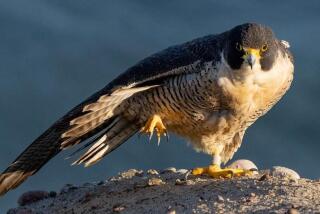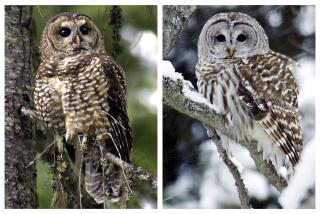Farmers scrap scarecrows in favor of falcons
BURBANK, WASH. — It’s an apt name for a predator brought in to scare away pests: Chase.
Diving and soaring over a southeast Washington blueberry patch, the aplomado falcon chases pesky starlings and sparrows to prevent them from feasting on the ripe fruit.
Farmer Jim Lott smiles as he watches the bird work. Lott is one of 17 farmers nationwide who have signed up for a program, approved late last year by the U.S. Fish and Wildlife Service, that allows the use of predator birds to control pest birds that damage or forage on crops.
Wildlife officials say three farmers have signed up in Texas, where pest birds feast on piles of grain at dairy farms and feed lots and ruin the feed by defecating on it. Seven farmers, including Lott, have signed on in the Pacific Northwest, where starlings infuriate fruit growers with their gluttonous ways.
“We never expected a whole lot of people to get them, but it did make sense to allow the use of raptors to control problem flocks of birds, agricultural pests, because in many ways, that’s probably more environmentally sound than other methods people might use,” said George Allen, a permits and regulations official for the Fish and Wildlife Service in Arlington, Va.
“I expect the kinds of uses will expand in the future, but it’s still early in the game,” he said.
Farmers have long battled birds and wildlife that damage or forage on their crops, causing an estimated $944 million in damage in one year alone, according to the U.S. Department of Agriculture’s wildlife damages program report in 2007.
In many places, farmers and wildlife managers have gotten creative in handling the problem. Pyrotechnics and laser shows have been used to scare crows away from crops or seabirds and pigeons from airports.
Not all methods are lethal, but in 2004, the most recent year for which data were available, the Agriculture Department killed more than 2.7 million nuisance animals. The majority were starlings, nonnative birds that destroy crops and contaminate livestock feed and are considered an invasive species.
Starlings have long been a nuisance to Northwest fruit and berry growers, who have tried countless ways to get rid of them: reflective ribbon, squawking bird recordings and booming propane cannons, firing at all hours and aggravating neighbors.
Enter the new regulations, which allow indigenous birds, largely protected under the Migratory Bird Treaty Act of 1918, to be used for bird abatement in agriculture. In the past, only nonindigenous birds could be employed, raising a number of problems.
Nonnative birds weren’t always attracted to the species the farmers were hoping to eradicate, and they have a tendency to just fly away, Allen said.
“We don’t want to be introducing a nonnative species,” he said. “If you lose a peregrine or prairie falcon that is native to North America, it’s not as big an issue as losing something that’s not native.”
Lott bought out one of two aplomado falconers in the United States to use at his blueberry farm. They rarely catch the starlings, he said.
That’s where bird abatement differs from falconry, because the predators aren’t intended to catch the birds, but rather to scare them away.
“In my mind, we’re not really pushing any environmental laws or rules. It’s just a natural thing, very natural, to the farm. We’re not shooting guns or any of the other things that the birds require,” he said.
Lott hopes to help other farmers try the same thing. Already, a couple of large farms have expressed interest.
State wildlife officials in Washington work with about 60 growers in areas where starlings are considered a major problem. In four counties, they’ve begun trapping the birds, but starlings are highly prolific, nesting up to twice a year and producing a lot of offspring.
Falcons, already part of the natural environment, may scare the birds away from a particular area, but the starlings just move on to become someone else’s problem, said Roger Woodruff, Washington state director of the Agriculture Department’s Animal and Plant Health Inspection Service.
“You might move them from one blueberry patch to another. You might even move them out of the area,” he said. “But falcons are a scare tactic, and we always want to use an integrated approach. We want to have a whole tool bag full of methods -- any and all methods that are effective and safe -- and I view falconry as one method that could have some use.”
More to Read
Sign up for Essential California
The most important California stories and recommendations in your inbox every morning.
You may occasionally receive promotional content from the Los Angeles Times.









